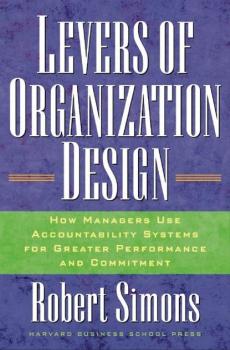Robert Simons
Список книг автора Robert SimonsLevers Of Organization Design
The design of an organization–the accountability system that defines roles, rights, and responsibilities throughout the firm–has a direct impact on the performance of every employee. Yet, few leaders devote focused attention to how this design is chosen, implemented, and adjusted over time. Robert Simons argues that by viewing design as a powerful and proactive management lever–rather than an inevitable outcome of corporate evolution–leaders can maximize productivity across every level of the organization. Levers of Organization Design presents a new design theory based on four key yet often underrated categories: customer definition, critical performance variables, creative tension, and commitment to mission. Building from these core areas, Simons lays out a step-by-step process leaders can follow to create structures and accountability systems that positively influence how people do their work, where they focus their attention, and how their activities can be aligned to contribute to overall strategic goals. He also introduces four levers of organizational design–unit configuration, diagnostic control systems, interactive networks, and responsibility to others–that leaders can manipulate to improve overall organizational efficiency and effectiveness vastly. For anyone accountable for measuring and managing performance, this book shows how good design can become an organization's roadmap to success. Robert Simons is the Charles M. Williams Professor of Business Administration in the accounting & control area at Harvard Business School.
Levers of Control
Based on a ten-year examination of control systems in over 50 U.S. businesses, this book broadens the definition of control and establishes a critical bridge between the disciplines of strategy and accounting and control. In addition to the more traditional diagnostic control systems, Simons identifies three new control systems that allow strategic change: belief systems that communicate core values and provide inspiration and direction, boundary systems that frame the strategic domain and define the limits of freedom, and interactive systems that provide flexibility in adapting to competitive environments and encourage organizational learning. These four control systems, according to Simons, will provide managers with the basic levers for pursuing strategic objectives.
Seven Strategy Questions
To stay ahead of the pack, you must translate your organization's competitive strategy into the day-to-day actions carried out in your company. That means channeling resources into the right efforts, achieving the right balance between innovation and control, and getting everyone pulling in the same direction. How to keep all this on track?Identify critical gaps in your strategy execution processes, focus on the most important choices you must make, and understand what's at stake in each one. In this concise guide, Harvard Business School professor Robert Simons presents the seven key questions you and your team must continually ask, beginning now. These questions–including «Who is our primary customer?» «What critical performance variables are we tracking?» and «What strategic uncertainties are keeping us awake at night?»–force you to reexamine the emerging data and unspoken assumptions underlying your strategy and how it's implemented through your business processes and structures. Simons's extensive examples then help you understand your options and position you to make the tough choices needed to excel at execution.Drawing on decades of research into performance management systems and organization design, Seven Strategy Questions is a no-nonsense, must-read resource for all leaders in your organization.
Control in an Age of Empowerment
In <i>Control in an Age of Empowerment</i>, Robert Simons explains how to give employees the freedom to innovate while protecting your firm from loose cannons. Using powerful examples, Simons shows how to apply four powerful management «levers» to balance autonomy with control: Traditional diagnostic control systems, Belief systems, Boundary systems, and Interactive control systems. Used in concert, these four levers give you the control you need–without sacrificing the creative thinking your company can't do without. Since 1922, <i>Harvard Business Review</i> has been a leading source of breakthrough ideas in management practice. The Harvard Business Review Classics series now offers you the opportunity to make these seminal pieces a part of your permanent management library. Each highly readable volume contains a groundbreaking idea that continues to shape best practices and inspire countless managers around the world.



